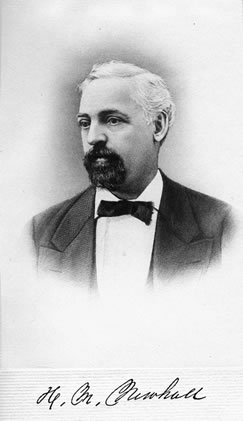About H.M. Newhall

Henry Mayo Newhall was a California Gold Rush pioneer who was born in 1825 in Saugus, Massachusetts. Newhall was working as an auctioneer on the East Coast in 1849 when news of the discovery of gold in California reached him. He immediately packed his belongings, boarded a ship, and headed toward San Francisco through Panama.
Unfortunately, he became sick during his trip across Panama. The illness delayed his arrival in California by six months. When the 25-year-old Newhall finally reached San Francisco in July of 1850, he headed directly for the Sierra foothills with the intent of making his fortune in gold. He soon realized that all the promising mining sites had already been claimed, and that he was too late to strike it rich in the mining fields.
Dejectedly, he returned to San Francisco to begin his eastward trip home. While waiting for his ship, he watched as other ships arrived in port, unloaded their goods, and sold their valuable cargoes right on the docks. Newhall recognized an opportunity. He opened his trunk and used his auctioneering skills to sell off most of his personal belongings, some at a hefty profit. The last item he auctioned off was his ticket home.
The rest, as they say, is history. Newhall stayed in San Francisco and built an auctioneering and import/export business. By 1853, the firm of H. M. Newhall & Company was thriving.
As Newhall prospered, another up-and-coming enterprise captured his imagination — railroads. In the 1860s, he began investing in fledgling new business ventures dedicated to building railroads to connect San Francisco with other cities in the West. By his fortieth birthday, Newhall had become president of the San Francisco-San Jose Railroad Company, and was completing California's first railroad track system, a line between San Francisco and San Jose to the south.

His company commissioned the building of the locomotive "California," and he joined other civic leaders and dignitaries on its first run to San Jose. According to newspaper accounts published at the time, the "California" achieved the record speed of 67 miles per hour during that trip. Newhall and his partners eventually sold their railroad interests to the new Southern Pacific Railroad Company, and he became a director of that company.
In the 1870s, real estate and ranching became Newhall's next great enterprise. He invested the profits of his auction and railroad businesses in San Francisco real estate and in the purchase of Spanish land-grant ranchos in central and southern California. Between 1872 and 1875, Newhall acquired 143,000 acres of ranch land from Monterey County to Los Angeles County.
His most important acquisition was Rancho San Francisco, a parcel of more than 40,000 acres covering much of the Santa Clarita Valley in northern Los Angeles County. He granted a right-of-way to the Southern Pacific Company, and the first tracks connecting San Francisco with Los Angeles were laid across his ranch. Southern Pacific named the station site Newhall. A few years later a nearby station was named Saugus, after Henry's birthplace in Massachusetts.
After Newhall's death in 1882, his widow and five sons incorporated his ranch properties into The Newhall Land & Farming Company. Over the next 86 years, the company was controlled exclusively by the Newhall family. In the 1960s it became a public corporation listed on the New York Stock Exchange, active in real estate, and developed the planned community of Valencia in the Santa Clarita Valley.
In 2004, the company was purchased by Lennar Corporation, a national real estate development company. As a subsidiary, Newhall Land is currently finalizing the planning of a new community, to be called "Newhall Ranch," on 19 square miles of land that borders Valencia to the north and west.